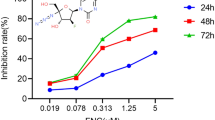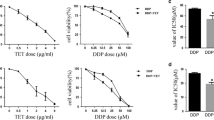Abstract
Purpose
Non-small cell lung cancer (NSCLC) is the most common type of lung cancer and ranked top in terms of incidence and mortality in men and women. Recently, improvements in treatment approaches for NSCLC have reported, but still, there is a need to devise innovative treatment strategies, especially to manage the advanced and metastatic stage of NSCLC. Aloperine (ALO), an herbal alkaloid, has exerted anti-cancer effects in many cancers. However, the use of any chemotherapeutic agents is dose limited due to possible adverse effects and drug-resistance issues. Therefore, a combination of chemotherapy with viral-based targeted gene therapy may provide a novel treatment strategy for NSCLC.
Methods/results
In this study, the results of the MTT and flow cytometry-based assays showed that Aloperine–Adbic (adenoviral vector expressing p14ARF/p53) combined treatment on NSCLC cells synergistically produced anti-proliferative effects, induced apoptosis, and arrested cell cycle at the G1 phase. Furthermore, the expression analysis suggested that the p53/p21 pathway might contribute to achieving aforesaid cytotoxic effects. The ALO–Adbic combined treatment prolonged the percent survival of NSCLC xenograft models.
Conclusion
In conclusion, ALO–Adbic combination can produce synergistic anti-cancer effects at low doses, and may offer a more effective and less toxic new treatment strategy for NSCLC.







Similar content being viewed by others
Availability of data and material
The data sets used and/or analyzed following standard procedures during the current study and are available from the corresponding author on reasonable request.
References
Andrews P, Howell S (1990) Cellular pharmacology of cisplatin: perspectives on mechanisms of acquired resistance. Cancer Cells (Cold Spring Harbor, NY: 1989) 2:35–43.
Bates S, Phillips AC, Clark PA, Stott F, Peters G, Ludwig RL, Vousden KH (1998) p14 ARF links the tumour suppressors RB and p53. Nature 395:124
Brennen WN, Chen S, Denmeade SR, Isaacs JT (2013) Quantification of mesenchymal stem cells (MSCs) at sites of human prostate cancer. Oncotarget 4:106
Brennen WN et al (2017) Mesenchymal stem cell infiltration during neoplastic transformation of the human prostate. Oncotarget 8:46710
Chen S et al (2018) Aloperine induces apoptosis and inhibits invasion in MG-63 and U2OS human osteosarcoma cells. Biomed Pharmacother 97:45–52
Chou T (1991) The median-effect principle and the combination index for quantitation of synergism and antagonism. Synerg Antagonism Chemother 1:61–102
Chou T, Martin N (2005) A computer program for quantitation of synergism and antagonism in drug combinations, and the determination of IC50 and ED50 and LD50 values CompuSyn for Drug Combinations: PC Software and User’s Guide; ComboSyn: Paramus. NJ, USA
de Stanchina E et al (1998) E1A signaling to p53 involves the p19ARFtumor suppressor. Genes Dev 12:2434–2442
Dulić V et al (1994) p53-dependent inhibition of cyclin-dependent kinase activities in human fibroblasts during radiation-induced G1 arrest. Cell 76:1013–1023
Ferlay J et al (2012) (2015) Cancer incidence and mortality worldwide: sources, methods and major patterns in GLOBOCAN. Int J Cancer 136:E359–E386
Gately D, Howell S (1993) Cellular accumulation of the anticancer agent cisplatin: a review. Br J Cancer 67:1171
Greenblatt M, Bennett WP, Hollstein M, Harris C (1994) Mutations in the p53 tumor suppressor gene: clues to cancer etiology and molecular pathogenesis. Cancer Res 54:4855–4878
Herbst RS, Morgensztern D, Boshoff C (2018) The biology and management of non-small cell lung cancer. Nature 553:446
Hollstein M, Sidransky D, Vogelstein B, Harris CC (1991) p53 mutations in human cancers. Science 253:49–53
Honda R, Yasuda H (1999) Association of p19ARF with Mdm2 inhibits ubiquitin ligase activity of Mdm2 for tumor suppressor p53. EMBO J 18:22–27
Huang W-S et al (2017) CIL-102-induced cell cycle arrest and apoptosis in colorectal cancer cells via upregulation of p21 and GADD45. PLoS ONE 12:e0168989
Huang Y, Tyler T, Saadatmandi N, Lee C, Borgstrom P, Gjerset RA (2003) Enhanced tumor suppression by a p14ARF/p53 bicistronic adenovirus through increased p53 protein translation and stability. Cancer Res 63:3646–3653
Jemal A et al (2018) Higher lung cancer incidence in young women than young men in the United States. N Engl J Med 378:1999–2009
Kallel H, Kamen AA (2015) Large-scale adenovirus and poxvirus-vectored vaccine manufacturing to enable clinical trials. Biotechnol J 10:741–747
Kannan K et al (2000) The p16INK4alpha/p19ARF gene mutations are infrequent and are mutually exclusive to p53 mutations in Indian oral squamous cell carcinomas. Int J Oncol 16:585–675
Kelland L (2007) The resurgence of platinum-based cancer chemotherapy. Nat Rev Cancer 7:573
Kim MS et al (2014) Naproxen induces cell-cycle arrest and apoptosis in human urinary bladder cancer cell lines and chemically induced cancers by targeting PI3K. Cancer Prev Res 7:236–245
Lee Y-R, Chen S-H, Lin C-Y, Chao W-Y, Lim Y-P, Yu H-I, Lu C-H (2018) Vitro antitumor activity of aloperine on human thyroid cancer cells through caspase-dependent apoptosis. Int J Mol Sci 19:312
Liang L, Wang X-Y, Zhang X-H, Ji B, Yan H-C, Deng H-Z, Wu X-R (2012) Sophoridine exerts an anti-colorectal carcinoma effect through apoptosis induction in vitro and in vivo. Life Sci 91:1295–1303
Ling Z et al (2018) Aloperine executes antitumor effects through the induction of apoptosis and cell cycle arrest in prostate cancer in vitro and in vivo. OncoTargets Ther 11:2735
Liu J-S et al (2019) Aloperine induces apoptosis and G2/M cell cycle arrest in hepatocellular carcinoma cells through the PI3K/Akt signaling pathway. Phytomedicine 61:152843
Maher A, Miake-Lye I, Beroes J, Shekelle P (2012) Treatment of metastatic non-small cell lung cancer: a systematic review of comparative effectiveness and cost-effectiveness
Miller KD et al (2016) Cancer treatment and survivorship statistics, 2016. CA Cancer J Clin 66:271–289
Molina JR, Yang P, Cassivi SD, Schild SE, Adjei AA Non-small cell lung cancer: epidemiology, risk factors, treatment, and survivorship. In: Mayo clinic proceedings, 2008, vol 5. Elsevier, pp 584–594
Muhammad T, Sakhawat A, Khan AA, Ma L, Gjerset RA, Huang Y (2019) Mesenchymal stem cell-mediated delivery of therapeutic adenoviral vectors to prostate cancer. Stem Cell Res Ther 10:190
Muthana M et al (2011) Use of macrophages to target therapeutic adenovirus to human prostate tumors. Can Res 71:1805–1815
Myers TJ, Granero-Molto F, Longobardi L, Li T, Yan Y, Spagnoli A (2010) Mesenchymal stem cells at the intersection of cell and gene therapy. Expert Opin Biol Ther 10:1663–1679
Palmero I, Pantoja C, Serrano M (1998) p19 ARF links the tumour suppressor p53 to Ras. Nature 395:125
Pinyol M et al (2000) INK4a/ARFLocus alterations in human non-Hodgkin's lymphomas mainly occur in tumors with wild-type p53 gene. Am J Pathol 156:1987–1996
Planas-Silva MD, Weinberg RA (1997) The restriction point and control of cell proliferation. Curr Opin Cell Biol 9:768–772
Ramalingam S, Belani C (2008) Systemic chemotherapy for advanced non-small cell lung cancer: recent advances and future directions. Oncologist 13:5–13
Sakhawat A, Liu Y, Ling Ma TM, Wang S, Zhang L, Cong X, Huang Y (2017) Upregulation of Coxsackie adenovirus receptor sensitizes cisplatin-resistant lung cancer cells to CRAd-induced inhibition. J Cancer 8:1425
Sarkar D, Vemula PK, Zhao W, Gupta A, Karnik R, Karp JM (2010) Engineered mesenchymal stem cells with self-assembled vesicles for systemic cell targeting. Biomaterials 31:5266–5274
Schweizer MT et al (2019) A phase I study to assess the safety and cancer-homing ability of allogeneic bone marrow-derived mesenchymal stem cells in men with localized prostate cancer. Stem Cells Trans Med 8:441–449
Serakinci N, Cagsin H (2019a) Programming hMSCs into potential genetic therapy in cancer critical reviews™ in eukaryotic gene expression 29
Serakinci N, Cagsin H (2019b) Turning stem cells homing potential into cancer specific drug delivery machines. Ann Transl Med 7
Song X-l et al (2017) Casticin induces apoptosis and G0/G1 cell cycle arrest in gallbladder cancer cells. Cancer Cell Int 17:9
Spiro SG, Porter JC (2002) Lung cancer—where are we today? Current advances in staging and nonsurgical treatment. Am J Respir Crit Care Med 166:1166–1196
Thomas A, Liu SV, Subramaniam DS, Giaccone G (2015) Refining the treatment of NSCLC according to histological and molecular subtypes. Nat Rev Clin Oncol 12:511
Tian D, Li Y, Li X, Tian Z (2018) Aloperine inhibits proliferation, migration and invasion and induces apoptosis by blocking the Ras signaling pathway in human breast cancer cells. Mol Med Rep 18:3699–3710
Torre LA, Bray F, Siegel RL, Ferlay J, Lortet-Tieulent J, Jemal A (2015) Global cancer statistics, 2012. CA Cancer J Clin 65:87–108
Torre LA, Sauer AMG, Chen MS Jr, Kagawa-Singer M, Jemal A (2016) Siegel RL (2016) Cancer statistics for Asian Americans, Native Hawaiians, and Pacific Islanders converging incidence in males and females CA. Cancer J Clin 66:182–202
Wang H, Guo S, Qian D, Qian Y, Duan JA (2012) Comparative analysis of quinolizidine alkaloids from different parts of Sophora alopecuroides seeds by UPLC–MS/MS. J Pharmaceut Biomed Anal 67:16–21
Wang H et al (2015) Aloperine executes antitumor effects against multiple myeloma through dual apoptotic mechanisms. J Hematol Oncol 8:26
Williams GH, Stoeber K (2012) The cell cycle and cancer. J Pathol 226:352–364
Wu X, Bayle JH, Olson D, Levine AJ (1993) The p53-mdm-2 autoregulatory feedback loop. Genes Dev 7:1126–1132
Xu Z et al. (2017) Reducing autophagy and inducing G1 phase arrest by aloperine enhances radio-sensitivity in lung cancer cells. Oncol Rep
Yuan X-Y, Liu W, Zhang P, Wang R-Y, Guo J-Y (2010) Effects and mechanisms of aloperine on 2, 4-dinitrofluorobenzene-induced allergic contact dermatitis in BALB/c mice. Eur J Pharmacol 629:147–152
Zhang L et al (2001) Effects of matrine on proliferation and differentiation in K-562 cells. Leukemia Res 25:793–800
Zhang Z et al (2012) Effects of matrine on proliferation and apoptosis in gallbladder carcinoma cells (GBC-SD). Phytother Res 26:932–937
Zhang L, Jiang J, Tan R (1998) Effects of matrine on telomerase activity and cell cycle in K562 cell. Chin J Oncol 20:328–329
Zhang L, Zheng Y, Deng H, Liang L, Peng J (2014) Aloperine induces G2/M phase cell cycle arrest and apoptosis in HCT116 human colon cancer cells. Int J Mol Med 33:1613–1620
Zhou C, Gao H, Sun X, Shi H, Liu W, Yuan H, Wang Z (1989) Anti-inflammatory and anti-allergic action of aloperine. Acta Pharmacol Sin 10:360–365
Acknowledgements
We are very thankful to Ming Zhao in Torrey Pines Institute for Molecular Studies for her technical assistance, and Beijing Inmay Future Biopharma Inc. to provide experimental materials.
Funding
This research was funded by National Natural Science Foundation OF China (Grant # 81472209) and Key Programs of Beijing Municipal Science and Technology Commission (Grant # K2015311201501).
Author information
Authors and Affiliations
Contributions
TM and AS contributed in designing and conducting experiments in this study. KAA also performed experiments. HH and HRK assisted in data analysis and manuscript writing. WJ and YH overall supervised the research work.
Corresponding author
Ethics declarations
Conflict of interest
Authors declared no conflict of interest.
Ethical approval
Study was approved by ethical committee of Beijing University of Technology (approval number IRB-1507).
Additional information
Publisher's Note
Springer Nature remains neutral with regard to jurisdictional claims in published maps and institutional affiliations.
Electronic supplementary material
Below is the link to the electronic supplementary material.
Rights and permissions
About this article
Cite this article
Muhammad, T., Sakhawat, A., Khan, A.A. et al. Aloperine in combination with therapeutic adenoviral vector synergistically suppressed the growth of non-small cell lung cancer. J Cancer Res Clin Oncol 146, 861–874 (2020). https://doi.org/10.1007/s00432-020-03157-2
Received:
Accepted:
Published:
Issue Date:
DOI: https://doi.org/10.1007/s00432-020-03157-2




